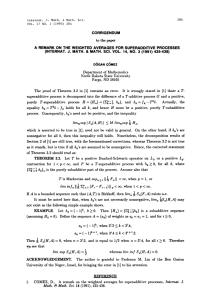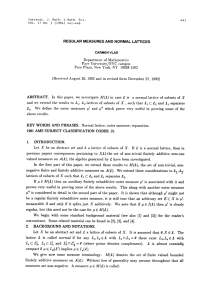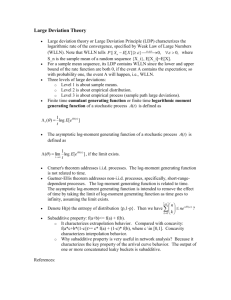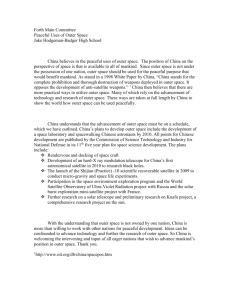ON FINITELY SUBADDITIVE OUTER MEASURES AND MODULARITY PROPERTIES CHARLES TRAINA
advertisement
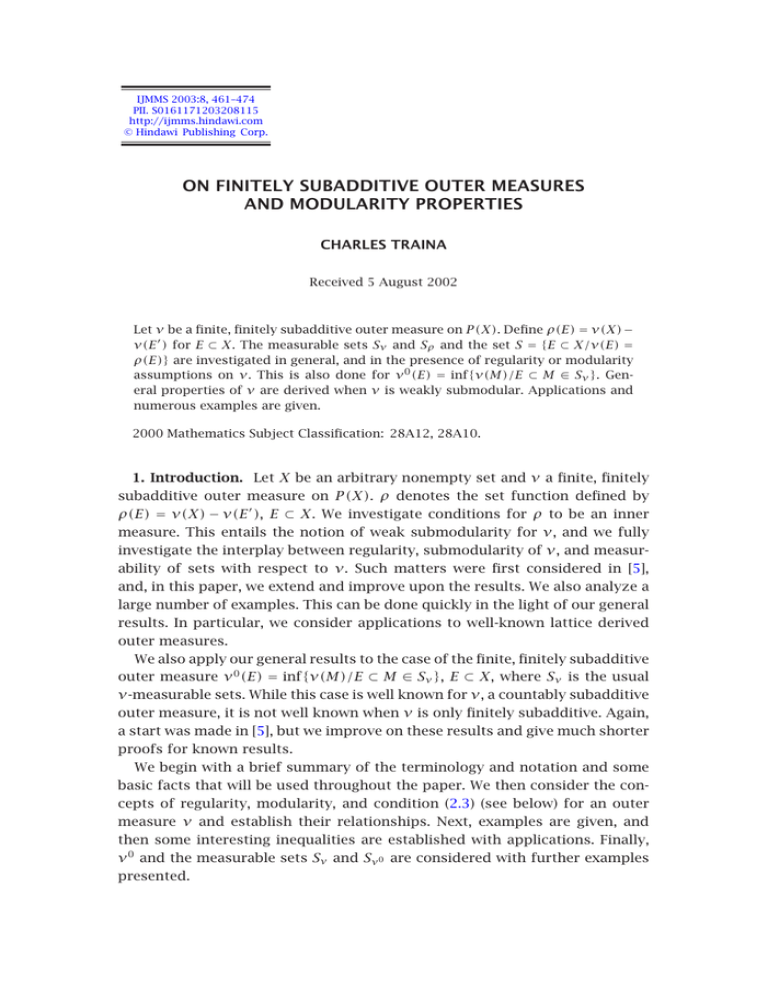
IJMMS 2003:8, 461–474
PII. S0161171203208115
http://ijmms.hindawi.com
© Hindawi Publishing Corp.
ON FINITELY SUBADDITIVE OUTER MEASURES
AND MODULARITY PROPERTIES
CHARLES TRAINA
Received 5 August 2002
Let ν be a finite, finitely subadditive outer measure on P (X). Define ρ(E) = ν(X)−
ν(E ) for E ⊂ X. The measurable sets Sν and Sρ and the set S = {E ⊂ X/ν(E) =
ρ(E)} are investigated in general, and in the presence of regularity or modularity
assumptions on ν. This is also done for ν 0 (E) = inf{ν(M)/E ⊂ M ∈ Sν }. General properties of ν are derived when ν is weakly submodular. Applications and
numerous examples are given.
2000 Mathematics Subject Classification: 28A12, 28A10.
1. Introduction. Let X be an arbitrary nonempty set and ν a finite, finitely
subadditive outer measure on P (X). ρ denotes the set function defined by
ρ(E) = ν(X) − ν(E ), E ⊂ X. We investigate conditions for ρ to be an inner
measure. This entails the notion of weak submodularity for ν, and we fully
investigate the interplay between regularity, submodularity of ν, and measurability of sets with respect to ν. Such matters were first considered in [5],
and, in this paper, we extend and improve upon the results. We also analyze a
large number of examples. This can be done quickly in the light of our general
results. In particular, we consider applications to well-known lattice derived
outer measures.
We also apply our general results to the case of the finite, finitely subadditive
outer measure ν 0 (E) = inf{ν(M)/E ⊂ M ∈ Sν }, E ⊂ X, where Sν is the usual
ν-measurable sets. While this case is well known for ν, a countably subadditive
outer measure, it is not well known when ν is only finitely subadditive. Again,
a start was made in [5], but we improve on these results and give much shorter
proofs for known results.
We begin with a brief summary of the terminology and notation and some
basic facts that will be used throughout the paper. We then consider the concepts of regularity, modularity, and condition (2.3) (see below) for an outer
measure ν and establish their relationships. Next, examples are given, and
then some interesting inequalities are established with applications. Finally,
ν 0 and the measurable sets Sν and Sν 0 are considered with further examples
presented.
462
CHARLES TRAINA
2. Background and notations. Throughout this section and the rest of the
paper, ν will designate a finite-valued, finitely subadditive outer measure defined on the power set P (X) of a nonempty set X. ρ will designate the associated set function ρ(E) = ν(X) − ν(E ), where E ⊂ X, and the prime will
designate complement. Clearly, ρ(E) ≤ ν(E), for all E ⊂ X. ρ, in general, is not
an inner measure (see Example 4.2). Furthermore, we let
S = E ⊂ X/ρ(E) = ν(E)
(2.1)
and Sν , Sρ denote the ν-measurable and ρ-measurable sets, respectively, where,
in general, if λ is a nonnegative real-valued set function on P (X) with λ(φ) = 0,
then we denote
Sλ = E ⊂ X/λ(G) = λ(G ∩ E) + λ(G ∩ E ) ∀G ⊂ X .
(2.2)
It is well known that Sλ is an algebra and λ restricted to Sλ is a finitely additive
measure.
Again, let ν be a finite, finitely subadditive outer measure, then ν is regular
if, for any E ⊂ X, there exists an M ∈ Sν such that E ⊂ M and ν(E) = ν(M). If ν
is just 0-1 valued, then, clearly, ν is regular. If ν is regular, then E ∈ Sν if and
only if
ν(X) = ν(E) + ν(E )
(2.3)
(see [6]). Hence, we say that ν satisfies condition (2.3) if and only if E ∈ Sν
whenever ν(X) = ν(E) + ν(E ). Therefore, we can say that any regular outer
measure satisfies condition (2.3). The converse is false (see [6] and Section 4).
We also apply this to ρ.
We can express these matters in terms of the above sets, Sν and Sρ . Clearly,
Sν and Sρ are contained in S, while S = Sν if and only if condition (2.3) is
satisfied for ν, and S = Sρ if and only if condition (2.3) is satisfied by ρ. We
note, for example, that if ν satisfies condition (2.3), then S = Sν is an algebra.
However, this is not true in general (see Section 4).
Definition 2.1. Let Ᏹ be a collection of subsets of X such that Ᏹ is a lattice,
and let λ be a set function defined on Ᏹ such that
λ(E ∪ F ) + λ(E ∩ F ) ≤ λ(E) + λ(F )
(2.4)
for all E, F ∈ Ᏹ, then λ is submodular on Ᏹ. If the reverse inequality holds, then
λ is called supermodular on Ᏹ. It is called modular on Ᏹ if we have equality.
If Ᏹ = P (X), we usually leave off the words “on P (X),” and simply say, for
example, submodular.
ON FINITELY SUBADDITIVE OUTER MEASURES . . .
463
Next, let Ꮿ be a covering class of X such that φ ∈ Ꮿ, and let τ be a finite,
nonnegative set function defined on Ꮿ with τ(φ) = 0. Then, as well known,
λ(E) = inf
n
n
τ Ei /E ⊂
Ei , for all Ei ∈ Ꮿ
i=1
(2.5)
i=1
is a finite and finitely subadditive outer measure on P (X).
The following result (see [5]) is extremely useful especially for applications.
Theorem 2.2. Let Ꮿ, τ, and λ be as above. Then,
(a) if Ꮿ is closed under finite unions and if τ is finitely subadditive on Ꮿ,
then
λ(E) = inf λ(C)/E ⊂ C ∈ Ꮿ ,
where E ⊂ X;
(2.6)
if, in addition, τ is monotone, then λ = τ on Ꮿ;
(b) if Ꮿ is a lattice and if τ is submodular on Ꮿ, then
λ(E) = inf λ(C)/E ⊂ C ∈ Ꮿ
(2.7)
is submodular on P (X).
Finally, let ᏸ be a lattice of subsets of X such that φ, X ∈ ᏸ. Ꮽ(ᏸ) denotes the
algebra generated by ᏸ, and M(ᏸ) denotes the set of all nontrivial, nonnegative,
finitely additive measures on Ꮽ(ᏸ). MR (ᏸ) denotes the set of all those µ ∈
M(ᏸ) which are ᏸ-regular. M(ᏸ), MR (ᏸ), and other subsets of M(ᏸ) have
been extensively studied in the literature; we cite just a few recent papers
[1, 4, 7, 8, 9, 10].
In Theorem 2.2, take Ꮿ = ᏸ , the complementary lattice to ᏸ, and τ = µ ∈
M(ᏸ). Then, writing µ for λ, we have the following theorem.
Theorem 2.3. If µ ∈ M(ᏸ), then
µ (E) = inf µ(ᏸ )/E ⊂ L , L ∈ ᏸ ,
(2.8)
for E ⊂ X, is a finite and finitely subadditive outer measure on P (X) and µ is
submodular on P (X). Also,
ρ(E) = µ (X) − µ (E ) = µ(X) − µ (E ) = sup µ(L)/L ⊂ E, L ∈ ᏸ
(2.9)
which has been denoted in the literature by µi (E).
We now proceed to extend and improve results in [5].
3. Modularity results. We again stress the fact that the finitely subadditive
outer measure ν is always assumed to be finite valued. If this is not the case,
then ρ(E) = ν(X) − ν(E ), for E ⊂ X, need not be defined. We have noted that
464
CHARLES TRAINA
ρ need not be an inner measure (see Example 4.2). In order to see when ρ is
an inner measure, we introduce the following definition.
Definition 3.1. Let ν be a finite and finitely subadditive outer measure.
Then ν is weakly submodular if the submodular law
ν(E ∪ F ) + ν(E ∩ F ) ≤ ν(E) + ν(F ),
(3.1)
E, F ⊂ X, holds when E ∪ F = X.
We now have the following theorem.
Theorem 3.2. ρ is an inner measure if and only if ν is weakly submodular.
Proof. Suppose that ν is a weakly submodular outer measure; all we must
show is that
ρ(E ∪ F ) ≥ ρ(E) + ρ(F )
(3.2)
if E ∩ F = φ. Now, since E ∩ F = φ, E ∪ F = X. Therefore,
ν(E ∪ F ) + ν(E ∩ F ) ≤ ν(E ) + ν(F ).
(3.3)
Hence,
ν(X) − ν(E ∪ F ) + ν(X) − ν(E ∩ F ) ≥ ν(X) − ν(E ) + ν(X) − ν(F ).
(3.4)
That is,
ρ(E ∪ F ) ≥ ρ(E) + ρ(F ).
(3.5)
The proof of the converse is just as simple.
We noted in Section 2 that the set
S = E ⊂ X/ρ(E) = ν(E)
(3.6)
is not in general an algebra (see Example 4.4). However, we have the following
theorem.
Theorem 3.3. If ν is a finite, finitely subadditive outer measure and if ν is
submodular, then S is an algebra and ν, restricted to S, is a finitely additive
measure.
Proof. If E ∈ S, then, clearly, E ∈ S; while if E, F ∈ S, then, by the submodularity of ν which is of course equivalent to the supermodularity of ρ, we
have
ρ(E) + ρ(F ) ≤ ρ(E ∪ F ) + ρ(E ∩ F )
≤ ν(E ∪ F ) + ν(E ∩ F )
≤ ν(E) + ν(F ) = ρ(E) + ρ(F ).
(3.7)
ON FINITELY SUBADDITIVE OUTER MEASURES . . .
465
This, together with the fact that ρ ≤ ν, implies that
ρ(E ∪ F ) = ν(E ∪ F ),
ρ(E ∩ F ) = ν(E ∩ F ).
(3.8)
Hence, S is an algebra. The last proof of the theorem follows now directly from
(3.7).
We recall the following definition from [5].
Definition 3.4. Let ν be, as usual, a finite, finitely subadditive outer measure, and let Sν be the ν-measurable sets. We define
ν 0 = inf ν(M)/E ⊂ M ∈ Sν
(3.9)
and say that ν is approximately regular if ν = ν 0 .
It is clear from Theorem 2.2 that ν 0 is a finite, finitely subadditive, submodular outer measure and ν 0 (M) = ν(M) for M ∈ Sν . We will consider ν 0 in greater
detail in Section 6.
In Section 2, we have noted that ν is regular if each E ⊂ X has a measurable
cover M ∈ Sν . Clearly, regularity implies approximately regular, and, in the
case of ν being a countably subadditive outer measure where Sν is a σ -algebra,
the two notions coincide. However, this is not the case for finitely subadditive
outer measures (see Section 4). The next theorem follows immediately from
the definitions and the fact that ν is a finitely additive measure on Sν and
hence modular.
Theorem 3.5. If ν is a finite, finitely subadditive outer measure, then ν is
submodular if ν is approximately regular.
We now wish to investigate the relationship between modularity and condition (2.3) introduced in Section 2, and, in doing so, we will extend and improve
results in [5].
Theorem 3.6. (a) If ν is a finite, finitely subadditive outer measure, and if
ρ(E) = ν(X) − ν(E ) for E ⊂ X,
(3.10)
then Sν = Sρ .
(b) If ν is also submodular on P (X), then Sν = Sρ = S.
Proof. (a) Let E ∈ Sν . Then, ν(A) = ν(A ∩ E) + ν(A ∩ E ) for A ⊂ X. Now,
ρ(A ∩ E) = ν(X) − ν(A ∪ E ),
ρ(A ∩ E ) = ν(X) − ν(A ∪ E).
(3.11)
ρ(A ∩ E) + ρ(A ∩ E ) = 2ν(X) − ν(A ∪ E ) − ν(A ∪ E).
(3.12)
Therefore,
466
CHARLES TRAINA
But
ν(A ∪ E) = ν (A ∪ E) ∩ E + ν (A ∪ E) ∩ E = ν(E) + ν(A ∩ E ),
ν(A ∪ E ) = ν (A ∪ E ) ∩ E + ν (A ∪ E ) ∩ E = ν(A ∩ E) + ν(E ).
(3.13)
Substituting in (3.12), we have
ρ(A ∩ E) + ρ(A ∩ E ) = 2ν(X) − ν(E) − ν(A ∩ E ) − ν(E ) − ν(A ∩ E)
= ν(X) − ν(A ∩ E) − ν(A ∩ E )
= ν(X) − ν(A )
(3.14)
= ρ(A).
Hence, E ∈ Sρ , so Sν ⊂ Sρ . Similarly, Sρ ⊂ Sν . Thus, Sν = Sρ ⊂ S.
(b) Since ν is submodular, ρ is supermodular and, therefore, Sρ = S by [5].
We also see from part (a) that ν satisfies condition (2.3) if and only if ρ satisfies
condition (2.3).
We can summarize some results in the following theorem.
Theorem 3.7. Let ν be a finite, finitely subadditive outer measure. Then, ν
regular implies that ν is approximately regular implies that ν is submodular
implies that ν satisfies condition (2.3).
We will see in the examples to follow that none of these implications can be
reversed in general.
We also note that if µ is a countably additive measure or an algebra, then
the customary induced Carathéodory outer measure µ ∗ is regular, and hence,
if finite, it satisfies condition (2.3). Of course, this is well known [3, 6].
4. Examples. In view of our general results in Sections 2 and 3, many specific examples become easier to analyze. We first consider the important examples µ ∈ M(ᏸ) with ν = µ and ρ = µi considered in Section 2. Using Theorems
2.3 and 3.7, we have the following theorem.
Theorem 4.1. Let µ ∈ M(ᏸ) and
µ (E) = inf µ(L )/E ⊂ L , L ∈ ᏸ .
(4.1)
Then, µ is submodular, and the following are equivalent:
(a) E ∈ Sµ = Sµi ,
(b) µ (E) = µi (E) where µi (E) = sup{µ(L)/L ⊂ E, L ∈ ᏸ},
(c) µ (E) + µ (E ) = µ (X).
This result was first proved in [1] in an entirely different manner. It is, as we
see, simply a special case of our more general theorems. It is also of interest
to see when µ is even more than submodular, namely, approximately regular.
We will look into this in Section 6.
ON FINITELY SUBADDITIVE OUTER MEASURES . . .
467
We now turn to more specific examples in order to show the need for certain
hypotheses in the theorems and in order to show that certain implications
cannot be reversed.
Example 4.2. Let X = {1, 2, 3, . . .} and define ν(φ) = 0, ν(X) = 2, ν(E) = 1
for all other sets E ⊂ X. Clearly, ν is an outer measure (countably subadditive),
and ρ(φ) = 0, ρ(X) = 2, ρ(E) = 1 for all E ⊂ X. Clearly, S = P (X) is of course an
algebra, and, clearly, Sν = {φ, X}. Thus, ν and ρ do not satisfy condition (2.3);
hence ν is not submodular and therefore not regular by Theorem 3.7. Also,
even though S is an algebra, ν is not a measure on S, which shows the need
for submodularity in Theorem 3.3. Also, by taking any two disjoint nonempty
sets whose union is not X, we see that ρ here is not an inner measure, so ν is
not even weakly submodular. We finally note that, unlike two-valued (0-1) ν, a
three-valued ν need not be regular.
Example 4.3. Again, let X = {1, 2, 3, . . .}, and let ν(φ) = 0, ν(X) = 3/2,
ν(E) = 1 for all other E ⊂ X (see [6]). Then, ρ(φ) = 0, ρ(X) = 3/2, ρ(E) = 1/2
for all other E. Clearly,
Sρ = Sν = S = {φ, X}.
(4.2)
However, as easily seen, ν is not weakly submodular and, therefore, not submodular; yet, ν restricted to S is trivially a measure. Also, condition (2.3) is of
course true for ν and ρ.
Example 4.4. Let X = {a, b, c, d} and define ν(φ) = 0, ν (any singleton) =
1, ν (any two-point set) = 1, ν (any three-point set) = 2, and ν(X) = 2. Then,
ρ(φ) = 0, ρ (singleton) = 0, ρ (a two-point set) = 1, ρ (a three-point set) = 1,
and ρ(X) = 2. Hence,
S = {φ, X, all two-point sets}
(4.3)
is not an algebra; therefore, ν and ρ do not satisfy (2.3), so ν is not submodular,
but ρ is an inner measure, so ν is weakly submodular. Also, here, Sν = Sρ =
{φ, X}.
We have already proved or observed the following implications pertaining
to the finite, finitely subadditive outer measure ν
regular
approximately regular
submodular
weakly submodular
condition (2.3).
(4.4)
That weakly submodular does not imply submodular is shown in Example 4.4.
That condition (2.3) does not imply submodular is shown in Example 4.3. We
468
CHARLES TRAINA
now give two type examples to show that submodularity does not imply approximately regular.
Example 4.5. Let X = {a, b, c} and define ν(φ) = 0, and ν (singleton) = 1,
ν (any two-point set) = 2, and ν(X) = 2. Then, ρ(φ) = 0, ρ (singleton) = 0,
ρ (a two-point set) = 1, and ρ(X) = 2. Thus, S = {φ, X}. It is also routine to
show that ν is submodular, and, hence, ν, ρ satisfy condition (2.3), so Sν = Sρ =
S = {φ, X}. However, this implies that ν 0 just assumes the two values 0 or 2.
Consequently, ν ≠ ν 0 and ν is not approximately regular which is equivalent
to regular when ν just assumes a finite number of values.
Next, we consider the following example.
Example 4.6. Let X be an uncountable set. Define ν(φ) = 0 = ν (a finite
set), ν (a countable set) = 1, and ν (an uncountable set) = 2. Then, ρ(φ) =
ρ (a finite set) = 0, ρ (a countable set) = 0, and ρ (an uncountable set) = 0, 1,
and 2, depending on whether its complement is uncountable, countable, or finite. ν is easily seen to be submodular, and, clearly, S = {φ, X, all finite sets and
their complements}. Thus, Sρ = Sν = S. Hence, ν 0 just assumes the values 0
and 2; so, ν 0 ≠ ν and ν is not approximately regular.
Finally, we consider an example for which ν is approximately regular but not
regular. Clearly, ν must be finitely subadditive but not countably subadditive
for such an example. Before proceeding to the example, we first recall that
if E ⊂ X, then a measurable cover of E is a set M ∈ Sν such that E ⊂ M and
ν(M) = ν(E). A measurable kernel of a set E ⊂ X is a set N ∈ Sν such that
N ⊂ E and ρ(N) = ρ(E). Clearly, E has a measurable cover if and only if E has
a measurable kernel.
Next, we note that if Ꮽ is an algebra of subsets of X and if µ is a finitely
additive measure on Ꮽ, then
µ · (E) = inf µ(A)/E ⊂ A ∈ Ꮽ ,
(4.5)
for E ⊂ X is, by Theorem 2.2, a finitely subadditive outer measure on P (X)
which extends µ on Ꮽ and Ꮽ ⊂ Sµ· . Also,
(µ · )0 (E) = inf µ · (B)/E ⊂ B ∈ Sµ· = µ · (E)
(4.6)
for E ⊂ X; so, µ · is approximately regular.
If X = [0, 1] and if S ⊂ X, we denote by S the closure of S and by S 0 the
interior of S.
Example 4.7. Let X = [0, 1] and let ν = c, outer Jordan content. Then, ρ = c,
inner Jordan content. Also, let 0 < α < 1, and denote by Cα the Cantor set of
measure 1−α. Although the Cantor set of measure zero is Jordan contentable,
this is not the case for Cα . Since c(Cα ) = α while c(Cα ) = 1 − c(Cα ) = 1 since
c(Cα ) = c(Cα0 ) = 0.
ON FINITELY SUBADDITIVE OUTER MEASURES . . .
469
It is clear by the above comments that c is approximately regular, and we now
note that it is not regular. We show that Cα does not have a contentable cover
or, equivalently, that Cα does not have a contentable kernel. Hence, suppose
that there exists S ⊂ Cα , S ∈ Sc , and
c(S) = c(S) = c Cα = α.
(4.7)
It readily follows that any open set containing an x ∈ Cα intersects S, so Cα ⊂ S.
Consequently,
[0, 1] = C α ⊂ S,
(4.8)
α = c(S) = c S = c[0, 1] = 1,
(4.9)
since Cα0 = φ. Thus,
a contradiction. Hence, Cα does not have a contentable kernel, and c is not
regular.
5. Further modularity properties. Again, ν denotes a finite, finitely subadditive outer measure on P (X), and ρ(E) = ν(X) − ν(E ) for E ⊂ X. In this
section, we prove a number of inequalities which significantly extend those in
[5], and, in the course of proving these inequalities, we also give an alternate
characterization of weakly submodular.
Theorem 5.1. Let ν be a finite and finitely subadditive outer measure. Then,
for E, F ⊂ X and E ∩ F = φ,
(a) ρ(E) + ρ(F ) ≤ ρ(E ∪ F ) if and only if ν is weakly submodular;
(b) ρ(E ∪ F ) ≤ ρ(E) + ν(F );
(c) ρ(E) + ν(F ) ≤ ν(E ∪ F ) if and only if ν is weakly submodular;
(d) ν(E ∪ F ) ≤ ν(E) + ν(F ).
Proof. (d) is of course true since ν is an outer measure. (a) was established
in Theorem 3.2.
We proceed to prove (b). By definition of ρ we have,
ρ(E ∪ F ) = ν(X) − ν(E ∩ F ),
(5.1)
but E = F ∪ (E ∩ F ), so ν(E ) ≤ ν(F ) + ν(E ∩ F ). Thus, ν(E ) − ν(F ) ≤
ν(E ∩ F ), and, by (5.1), we get
ρ(E ∪ F ) ≤ ν(X) − ν(E ) + ν(F ) = ρ(E) + ν(F ).
(5.2)
Finally we consider (c). Since E ∩ F = φ, F = E ∪ (F ∩ E ). Hence, ρ(F ) ≥
ρ(E) + ρ(F ∩ E ) since ν is weakly submodular. Now,
ρ(E) + ν(F ) = ν(X) + ρ(E) − ρ(F ) ≤ ν(X) − ρ(E ∩ F ) = ν(E ∪ F ).
(5.3)
470
CHARLES TRAINA
Conversely, suppose that, whenever A ∩ B = φ,
ρ(A) + ν(B) ≤ ν(A ∪ B).
(5.4)
Let E ∩ F = φ, so F = E ∪ (F ∩ E ). Taking A = E and B = F ∩ E , we get
ρ(E) + ν(F ∩ E ) ≤ ν(F ).
(5.5)
ρ(E) + ν(F ∩ E ) ≤ ν(X) − ρ(F ).
(5.6)
ρ(E) + ρ(F ) ≤ ν(X) − ν(F ∩ E ) = ρ(E ∪ F ).
(5.7)
Therefore,
So,
Hence, ρ is an inner measure and ν is weakly submodular.
Corollary 5.2. If ν is a finite, finitely subadditive, and weakly submodular
outer measure, then, for E, F ⊂ X, and E ∩ F = φ,
ρ(E) + ρ(F ) ≤ ρ(E ∪ F ) ≤ ρ(E) + ν(F ) ≤ ν(E ∪ F ) ≤ ν(E) + ν(F ).
(5.8)
Corollary 5.2 is a strong extension of a result in [5], where it is only proven
in the case of an approximately regular ν. Since, as we noted in Theorem 2.3
for a µ ∈ M(ᏸ), µ is submodular, we have the following corollary.
Corollary 5.3. For µ ∈ M(ᏸ) and E, F ⊂ X, E ∩ F = φ,
µi (E) + µi (F ) ≤ µi (E ∪ F ) ≤ µi (E) + µ (F ) ≤ µ (E ∪ F ) ≤ µ (E) + µ (F ).
(5.9)
Corollary 5.4. If ν is a finite, finitely subadditive, and weakly submodular
outer measure, then, for M ∈ Sν and E ⊂ X,
ρ(M) = ν(M) = ρ(M ∩ E) + ν(M ∩ E ).
(5.10)
Proof. By (b) and (c) of Theorem 5.1,
ρ(M) ≤ ρ(M ∩ E) + ν(M ∩ E ) ≤ ν(M) = ρ(M),
(5.11)
which completes the proof.
There are clearly many special ν, in addition to µ , to which we can apply
the above results. We will indeed consider one of these in Section 6. Further
applications should be clear.
ON FINITELY SUBADDITIVE OUTER MEASURES . . .
471
6. The outer measure ν 0 . As usual, ν denotes a finite, finitely subadditive
outer measure on P (X). In Definition 3.4, we defined the finite, finitely subadditive outer measure
ν 0 (E) = inf ν(M)/E ⊂ M ∈ Sν .
(6.1)
Then,
ν 0 (X) − ν 0 (E ) = ν(X) − ν 0 (E ) = sup ν(M)/M ⊂ E, M ∈ Sν
(6.2)
since ν 0 = ν on Sν ⊂ S, and we denote by ν0 ,
ν0 (E) = sup ν(M)/M ⊂ E, M ∈ Sν .
(6.3)
Also, it is clear that
ν0 ≤ ρ ≤ ν ≤ ν 0 .
(6.4)
Clearly, these ν 0 and ν0 fit the general framework of the previous sections. ν 0
and ν0 have been thoroughly investigated in the case where ν is a countably
subadditive outer measure (see [2]). They have also been investigated in the
finitely subadditive case in [5]. In the light of our stronger results, we can
improve on the results in [5] and also give considerably shorter proofs and
numerous examples. We now proceed to do this.
The following theorem is proved in [5], and we add the proof for completeness.
Theorem 6.1. Let ν be a finite and finitely subadditive outer measure. Then,
Sν ⊂ Sν 0 .
Proof. Let E ∈ Sν , and A ⊂ X be arbitrary. For ε > 0, there exists an M ∈ Sν
such that A ⊂ M and ν(M) < ν 0 (A) + ε. Now, A ∩ E ⊂ M ∩ E ∈ Sν , and A ∩ E ⊂
M ∩ E ∈ Sν . Hence,
ν 0 (A ∩ E) + ν 0 (A ∩ E ) ≤ ν(M ∩ E) + ν(M ∩ E ) = ν(M) < ν 0 (A) + ε,
(6.5)
and, therefore, E ∈ Sν 0 .
Next, we note that, for E ⊂ X,
ν 00 (E) = inf ν 0 (M)/E ⊂ M ∈ Sν0
≤ inf ν 0 (M)/E ⊂ M ∈ Sν ,
(6.6)
by Theorem 6.1, and this, in turn,
= inf ν(M)/E ⊂ M ∈ Sν
= ν 0 (E);
(6.7)
472
CHARLES TRAINA
so, ν 00 ≤ ν 0 . But we always have ν 00 ≥ ν 0 . Consequently, ν 00 = ν 0 ; so, ν 0 is
approximately regular, and we can use the results of the preceding sections
on ν 0 .
Theorem 6.2. Let ν be a finite, finitely subadditive outer measure. Then,
(a) ν 0 is approximately regular and hence submodular and satisfies condition (2.3);
(b) Sρ = Sν ⊂ Sν 0 = Sν0 = S ⊂ S, where S = {E ⊂ X/ν0 (E) = ν 0 (E)};
(c) if E, F ⊂ X and E ∩ F = φ, then
ν0 (E) + ν0 (F ) ≤ ν0 (E ∪ F ) ≤ ν0 (E) + ν 0 (F ) ≤ ν 0 (E ∪ F ) ≤ ν 0 (E) + ν 0 (F ); (6.8)
(d) for M ∈ Sν0 and E ⊂ X,
ν0 (M) = ν 0 (M) = ν0 (M ∩ E) + ν 0 (M ∩ E ).
(6.9)
Proof. (a) Since we have seen that ν 0 is approximately regular, (a) follows
from Theorem 3.7. (b) follows from Theorems 3.6 and 6.1(a), and since
ν0 (E) ≤ ρ(E) ≤ ν(E) ≤ ν 0 (E),
(6.10)
it follows that E ∈ S implies E ∈ S.
Corollary 6.3. If ν is a finite, finitely subadditive outer measure that satisfies condition (2.3), then Sρ = Sν = Sν0 = Sν 0 = S = S.
Proof. The proof follows immediately from Theorem 6.2(b), and since ν
satisfies condition (2.3), Sν = S.
Remark 6.4. We have shown that Sν ⊂ Sν 0 and that Sν = Sν 0 if ν satisfies
condition (2.3). It is certainly possible that Sν = Sν 0 even if condition (2.3) is
not satisfied (see examples below).
We do have, however, the following result.
Theorem 6.5. Let E ∈ Sν 0 , then E ∈ Sν if and only if there exists an M ⊂ E,
M ∈ Sν , and ν(E) = ν(M).
Proof. If the condition holds, then
ν(E) = ν(E ∩ M) + ν(E ∩ M ) = ν(M) + ν(E ∩ M ).
(6.11)
Hence, ν(E ∩ M ) = 0, so, E ∩ M ∈ Sν , and, therefore,
E = M ∪ (E ∩ M ) ∈ Sν .
(6.12)
The converse is of course clear.
Remark 6.6. In the case of a countably subadditive measure ν which is
finite, the condition in Theorem 6.5 is satisfied, and we always have Sν = Sν 0 .
ON FINITELY SUBADDITIVE OUTER MEASURES . . .
473
However, if ν can take on infinite values, then this is no longer the case. As
noted earlier, this is treated in full detail in [2].
Corollary 6.7. If ν is a finite, finitely subadditive outer measure and if
(a) ν just assumes a finite number of values on Sν or
(b) Sν is a σ -algebra, then Sν = Sν 0 .
Proof. In both cases, it is clear that the condition of Theorem 6.5 is satisfied.
We now consider several examples.
Example 6.8. We first consider the general example of a µ ∈ M(ᏸ). Since
µ is submodular, we have, by Corollary 6.3, Sµ = S(µ )0 . Suppose next that
µ ∈ MR (ᏸ). This is equivalent to ᏸ ⊂ Sµ . Hence,
µ (E) = inf µ(L )/E ⊂ L ∈ ᏸ
≥ inf µ (M)/E ⊂ M ∈ Sµ
0
(6.13)
= (µ ) (E) ≥ µ (E).
Thus, we have µ ∈ MR (ᏸ) that implies that (µ )0 = µ , that is, µ is approximately regular. The converse need not be true since, for any µ ∈ M(ᏸ) that
just assumes two values, µ is regular.
We next consider two specific examples.
Example 6.9. Let X, ν be as in Example 4.6. We saw that ν is submodular.
Hence, by Corollary 6.3, Sν = Sν0 . This also follows by Corollary 6.7. We also
note that ν is just finitely subadditive here.
Example 6.10. Let X = {1, 2, 3, . . .}; and define ν(φ) = 0, ν (a finite set) = 0,
ν(E) = 1 (if E is infinite and E is infinite), and ν(E) = 2 (if E is infinite and
E is finite), so, ν(X) = 2. Then, ρ(φ) = 0, ρ (a finite set) = 0, ρ(E) = 1 (if
E is infinite and E is infinite), and ρ(E) = 2 (if E is infinite and E is finite).
Thus, S = P (X) while Sν = {φ, X, E such that E or E is finite}. Thus, S ≠ Sν ;
so, condition (2.3) is not satisfied here but by Corollary 6.7 Sν = Sν 0 . Thus,
Sν = Sν 0 does not imply condition (2.3). We also note that ν here is clearly only
finitely subadditive.
Different examples in the case of a finite, finitely subadditive outer measure
of a general type can be found in [5].
References
[1]
[2]
P. M. Grassi, Outer measures and associated lattice properties, Int. J. Math. Math.
Sci. 16 (1993), no. 4, 687–694.
H. Hahn and A. Rosenthal, Set Functions, The University of New Mexico Press,
New Mexico, 1948.
474
[3]
[4]
[5]
[6]
[7]
[8]
[9]
[10]
CHARLES TRAINA
P. R. Halmos, Measure Theory, Van Nostrand, New York, 1950.
P.-S. Hsu, Characterizations of outer measures associated with lattice measures,
Int. J. Math. Math. Sci. 24 (2000), no. 4, 237–249.
J. E. Knight, Some remarks concerning finitely subadditive outer measures with
applications, Int. J. Math. Math. Sci. 21 (1998), no. 4, 653–669.
M. E. Munroe, Introduction to Measure and Integration, Addison-Wesley Mathematics Series, Addison-Wesley, Massachusetts, 1953.
J. Ponnley, On lattice associated outer measures and applications to smoothness
conditions, J. Math. Sci. (Calcutta) 9 (1998), no. 1, 57–69.
C. Traina, Outer measures associated with lattice measures and their application,
Int. J. Math. Math. Sci. 18 (1995), no. 4, 725–734.
, Lattice related outer measure inequalities on pairs of lattices, J. Math. Sci.
(Calcutta) 12 (2001), no. 2, 53–69.
S. Wibisono, Smoothness, regularity, and domination of lattice measures, J. Math.
Sci. (Calcutta) 6 (1995), no. 2, 47–60.
Charles Traina: Department of Mathematics and Computer Science, St. John’s University, 8000 Utopia Parkway, Jamaica, NY 11439, USA
E-mail address: trainac@stjohns.edu
